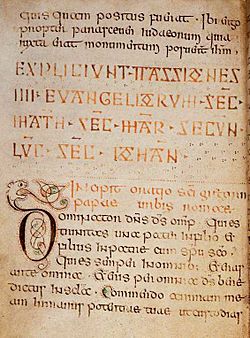Book of Nunnaminster facts for kids
Quick facts for kids The Book of Nunnaminster |
|
|---|---|
| British Library, Harley MS 2965 | |

Zoomorphic initial ‘d’: Book of Nunnaminster, f. 16v
|
|
| Type | Prayer book |
| Date | c.800–c.825 |
| Place of origin | England, S. (Mercia, diocese of Worcester?) |
| Language(s) | Latin, with Old English |
| Material | Parchment, ink |
| Size | 215 × 160 (175 × 140) mm |
| Condition | First quire missing |
| Script | Insular minuscule |
| Contents | Gospel extracts; prayers |
| Illumination(s) | 3 large initials with penwork, some zoomorphic. Smaller initials with coloured washes and red dots. |
| Other | Member of the Southumbrian 'Tiberius Group' |
The Book of Nunnaminster is a very old prayer book from the 800s. It was made by the Anglo-Saxons in England. Today, you can find it in the British Library in London.
This special book was written in a place called Mercia. The writing style used is called "insular script." This was a common way of writing in the British Isles back then. It was also similar to writing styles used in other parts of Europe.
Historians think that Ealhswith, who was the wife of Alfred the Great, might have owned this book later on.
Contents
What's Inside the Book of Nunnaminster?
The Book of Nunnaminster is a collection of important texts. It includes parts of the Gospels, which are stories about Jesus's life from the Bible.
It also has many prayers. These prayers were personal ones, not usually used in church services. Some of these prayers are about the Passion, which means the last days of Jesus's life.
The book also shares some poems with another old book called the Book of Cerne.
How Does the Book Look?
The Book of Nunnaminster is made from parchment, which is specially prepared animal skin. It measures about 21.5 cm by 16 cm.
The book has some beautiful decorated letters, called initials. Some of these letters are "zoomorphic", meaning they look like animals. For example, one letter 'd' looks like a cat!
Why is it Called Nunnaminster?
The name 'Nunnaminster' comes from St Mary's Abbey, Winchester. This abbey was also known as the Nunnaminster. It was a place where nuns lived and prayed.
Other Cool Old Books Like This
The Book of Nunnaminster is connected to a few other important old books. It is older than the Book of Cerne, but they share some similarities. It is also related to the Royal Prayerbook and the Harleian prayerbook. These books give us a peek into what life and religion were like a long time ago.

